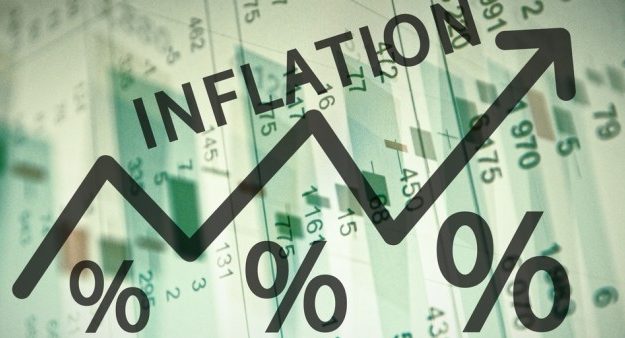Because inflation will trot. Wsj report

Higher inflation is likely to remain for years, economists predict. The deepening of the Wall Street Journal
Americans should brace themselves for several years of higher inflation than they have seen in recent decades, according to economists who expect the robust post-pandemic economic recovery to fuel a sharp rise in prices for a while.
Economists surveyed this month by the Wall Street Journal raised their predictions on how high inflation will be and for how long, from their previous expectations in April.
On average, respondents now expect inflation, excluding the volatile components of food and energy, to be up 3.2% in the fourth quarter of 2021 compared to a year earlier. They expect the annual increase to decline to just under 2.3% per year in 2022 and 2023.
This would mean an average annual increase of 2.58% from 2021 to 2023, putting inflation at the levels last seen in 1993.
"We are in a transition phase right now," said Joel Naroff, chief economist at Naroff Economics LLC. "We are moving into a period of inflation and higher interest rates than we have had in the past 20 years."
The measure of inflation – the Commerce Department's base price index for personal consumer spending – rose 3.4% in May from a year earlier, the largest increase since the early 1990s.
What Mr. Naroff and other respondents describe is a generational shift from low inflation over the past two decades, a shift that could create new challenges for families, politicians and investors who expected inflation closer to or below 2. %.
If economists' forecasts prove correct, Federal Reserve officials may need to raise rates sooner or more than they expect to keep inflation in check.
The Fed's preferred inflation indicator – the general PCE index, which includes food and energy prices – rose 3.9% in May, nearly double the central bank's 2% target. The Fed, in a report released Friday, reiterated its view that inflation has risen this year due to bottlenecks, hiring difficulties and other "largely transient factors" linked to the rebound of the economy from the effects of the pandemic. Most officials, in projections released last month, believed that inflation would drop to around 2% over the next two years, although there was more uncertainty about how quickly interest rates might need to be raised to get inflation.
At the Fed's June policy meeting, most officials predicted to hike interest rates from near zero by 2023. Many expected to hike rates next year. In March, most officials expected to keep rates steady until 2023.
About 58% of economists surveyed do not see the Fed raise interest rates until the second half of 2022 or later.
"Inflation is expected to rise longer and longer than the Fed previously thought," said Diane Swonk, Grant Thornton's chief economist. "The Fed will now likely raise rates in the first half of 2023, although some Fed presidents will pressure to move sooner."
Some respondents fear the Fed may move too slowly. "The danger is that monetary authorities are behind the curve," said Kevin Swift, chief economist at the American Chemistry Council. "I'm not saying hyperinflation is around the corner, just that a lot of things have come together in the last year, and the overall cost trend across the board is growing faster than in the last five or 10 years." .
Core PCE inflation only grew 1.7% per year, on average, between 1995 and 2019. Now the Fed wants inflation to rise above 2% for some time to make up for that deficit. .
Another key measure of inflation, the Department of Labor Consumer Price Index, which tends to be warmer than the PCE index, jumped 5% in May from a year earlier, the highest in nearly 13 years. Respondents expect the department to report on Tuesday that the CPI rose 4.7% in June from a year earlier. They expect the rate to drop to 4.1% by the end of the year. Their CPI forecasts for next year and 2023 hover between 2.4% and 2.7%.
Supply chain bottlenecks, higher shipping costs, and labor shortages may prove temporary as the market adjusts to disruptions. However, the combination of abundant federal stimulus funding, an unprecedented stash of household savings and the launch of vaccines is driving a surge in consumer demand, allowing many companies to significantly raise prices for the first time in. decades. If households and businesses begin to expect price increases, this dynamic can become self-fulfilling.
There are signs that consumers are starting to anticipate higher inflation. Consumer inflation expectations – the rate of inflation the median consumer expects in five to ten years – jumped to 2.8% in June, about the same rate as in 2014, according to the University of Michigan survey. consumers.
Higher inflation for several years would impact the economy in various ways. Consumers may find their family budgets squeezed. Rising borrowing costs could weigh on share value and could reduce growth in interest rate sensitive sectors such as construction. Higher inflation can also make it more difficult for businesses to plan for long-term investments.
“It's disruptive: you can't be sure what your costs are, if you can get supplies or what the costs will be in six months,” said Mr. Swift. "I wouldn't want to be in the construction industry and try to bid for a job when you don't know what the cost of steel will be in 18 months."
(Extract from the Epr press review)
This is a machine translation from Italian language of a post published on Start Magazine at the URL https://www.startmag.it/economia/perche-linflazione-trottera-report-wsj/ on Sun, 18 Jul 2021 06:01:40 +0000.
